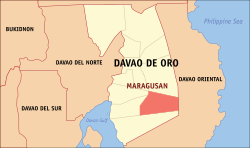Maragusan San Mariano | |
|---|---|
| Municipality of Maragusan | |
 Map of Davao de Oro with Maragusan highlighted | |
Location within the Philippines | |
| Coordinates: 7°19′01″N126°07′26″E / 7.3169°N 126.1239°E | |
| Country | Philippines |
| Region | Davao Region |
| Province | Davao de Oro |
| District | 1st district |
| Founded | November 25, 1977 |
| Barangays | 24 (see Barangays) |
| Government | |
| • Type | Sangguniang Bayan |
| • Mayor | Angelito "Lito" J. Cabalquinto |
| • Vice Mayor | Cesar C. Colina Sr. |
| • Representative | Maria Carmen S. Zamora-Apsay |
| • Electorate | 46,326 voters (2025) |
| Area | |
• Total | 394.27 km2 (152.23 sq mi) |
| Elevation | 813 m (2,667 ft) |
| Highest elevation | 1,544 m (5,066 ft) |
| Lowest elevation | 615 m (2,018 ft) |
| Population (2024 census) [3] | |
• Total | 67,759 |
| • Density | 170/km2 (450/sq mi) |
| • Households | 16,002 |
| Economy | |
| • Income class | 1st municipal income class |
| • Poverty incidence | 19.35 |
| • Revenue | ₱ 507.2 million (2022) |
| • Assets | ₱ 795.2 million (2022) |
| • Expenditure | ₱ 318.9 million (2022) |
| • Liabilities | ₱ 72.07 million (2021, 2022) |
| Service provider | |
| • Electricity | Northern Davao Electric Cooperative (NORDECO) |
| Time zone | UTC+8 (PST) |
| ZIP code | 8808 |
| PSGC | |
| IDD : area code | +63 (0)87 |
| Native languages | Davawenyo Cebuano Kalagan Mansaka Tagalog Ata Manobo |
| Website | www |
Maragusan, officially the Municipality of Maragusan (Cebuano : Lungsod sa Maragusan; Tagalog : Bayan ng Maragusan), is a municipality in the province of Davao de Oro, Philippines. According to the 2020 census, it has a population of 64,412 people. [5]


